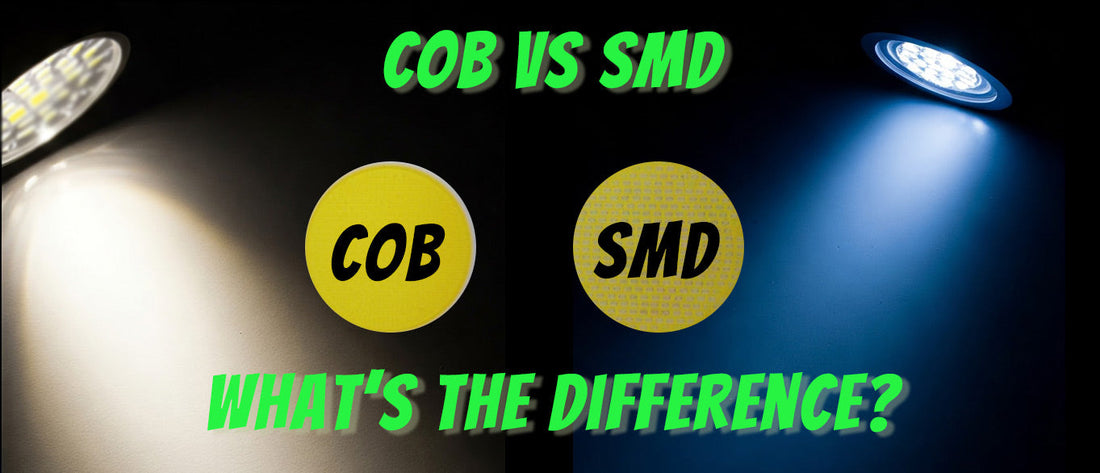COB vs. SMD LEDs: What's the Difference?
LED lighting has revolutionized the way we illuminate our world, offering energy efficiency and long lifespans. But the world of LEDs can be a little confusing, especially with terms like COB and SMD floating around. What do they mean, and which type of LED is right for your needs? This blog post breaks down the key differences between COB (Chip-on-Board) and SMD (Surface Mount Diode) LEDs to help you make an informed decision.

SMD LEDs: The Versatile Workhorse
SMD LEDs are the most common type you'll encounter. They're small, surface-mounted components that are soldered directly onto a circuit board. Think of the tiny LEDs on your TV remote, LED strip lights, or even some household light bulbs.
-
Characteristics of SMD LEDs:
- Size: Small and compact, allowing for flexible designs.
- Brightness: Available in a wide range of brightness levels.
- Color: Can produce a variety of colors, including white light with varying color temperatures (warm white, cool white, etc.). RGB (Red, Green, Blue) SMD LEDs can create millions of color combinations.
- Efficiency: Generally efficient, though efficiency varies depending on the specific SMD package.
- Applications: Widely used in various applications, from indicator lights and backlighting to general illumination.
-
Advantages of SMD LEDs:
- Versatility: Their small size and color options make them incredibly versatile.
- Cost-effective: SMD LEDs are generally more affordable than COB LEDs.
- Wide availability: They are readily available from numerous suppliers.
-
Disadvantages of SMD LEDs:
- Lower light intensity per unit area: Compared to COB LEDs, SMD LEDs typically produce less light from the same surface area.
- Can be less efficient at higher currents: Efficiency can decrease at higher drive currents.
- Multiple light sources: For larger lighting applications, multiple SMD LEDs are often required, which can create a less uniform light output.
COB LEDs: The High-Intensity Powerhouse
COB LEDs take a different approach. Instead of mounting individual LEDs onto a circuit board, multiple LED chips are bonded directly to a single substrate (typically ceramic or metal). This creates a single, large light-emitting surface.
-
Characteristics of COB LEDs:
- High light intensity: COB LEDs offer a very high light output from a relatively small area.
- Uniform light distribution: They produce a more even and consistent light compared to multiple SMD LEDs.
- Better thermal management: The single substrate helps dissipate heat more effectively, which can improve lifespan and performance.
- Color: Typically used for white light applications. While RGB COB LEDs exist, they are less common.
-
Advantages of COB LEDs:
- High lumen output: Ideal for applications requiring bright, powerful light.
- Excellent light uniformity: Creates a smooth and consistent light output.
- Improved thermal performance: Leads to longer lifespan and better efficiency at high drive currents.
-
Disadvantages of COB LEDs:
- Higher cost: COB LEDs are generally more expensive than SMD LEDs.
- Less versatile in color: Primarily used for white light applications.
- Larger size: While the light-emitting surface is compact, the overall package size can be larger than individual SMD LEDs.

COB vs. SMD: Which One Should You Choose?
The best choice depends on your specific needs:
-
Choose SMD LEDs if: You need a versatile, cost-effective solution for general lighting, backlighting, or applications requiring different colors. Think LED strips, indicator lights, and general-purpose light bulbs.
-
Choose COB LEDs if: You need high-intensity light output, excellent light uniformity, and efficient thermal management. Think high-bay lighting, spotlights, and other applications where brightness and consistent light quality are crucial.
In Summary:
| Feature | SMD LED | COB LED |
|---|---|---|
| Light Output | Moderate | High |
| Light Uniformity | Can be less uniform with multiple LEDs | Excellent |
| Color | Wide range, including RGB | Primarily white light |
| Cost | Lower | Higher |
| Efficiency | Good, but can decrease at high currents | Excellent, especially at high currents |
| Size | Small and compact | Larger package size, compact light surface |
| Applications | General lighting, backlighting, indicators | High-bay lighting, spotlights, high-intensity applications |
Understanding the differences between COB and SMD LEDs will help you choose the right technology for your lighting project. Whether you're illuminating your home, office, or a large industrial space, this guide should provide a solid foundation for making informed decisions.

